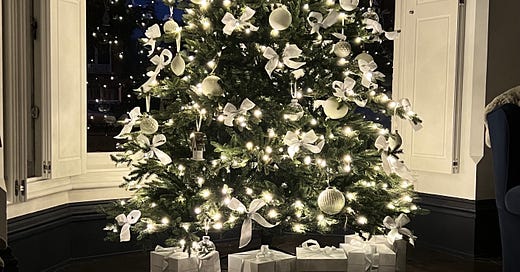Where do our Christmas traditions come from?
A very merry Christmas & happy holidays from HOME & HORT by JP Clark.
Hello everyone, I’m sending out a little something today instead of my usual Sunday slot as that is Christmas Eve and I’ll be busy being merry! I must apologise, as I’ve been ill all week and currently at home recovering before we go away. I had a different post planned, but it requires more energy than I can muster right now, so I’ve rustled something up that will hopefully inform and amuse. Hope you’re all doing well and aren’t too stressed out with all the preparations!
Four more sleeps till Santa comes down my chimney! Well, actually, I’m hoping he got the memo that he needs to divert our presents to Kansas City, as that’s where we will be. There won’t be any mince pies or a glass of sherry left out for him back in jolly old England, that’s for sure, so I hope he’s got GPS!
Talking of mince pies, as we’re all scurrying around to be ready for the big day, I thought it might be fun to take a little look at where some our favourite traditions come from. There’s a few that might surprise you and I’ve thrown in some joviality just for giggles.
Mince Pies
For all you lovely people that don’t live in the UK or other parts of The Commonwealth, Mince Pies in the 21st century are little round pies, usually made with shortcrust pastry and filled with a warming spiced fruit mix including sultanas, raisins, chopped apple and candied peel. A good dose of brandy and rum is most often thrown in for good measure.
The mince pie, however, was originally a savoury meaty treat and did indeed have actual meat in it, unlike today. According to Historic England, in the Tudor period the pies were rectangular and shaped to represent a manger. They often had a cute little pastry baby Jesus on top! Although, the thought of eating the son of god does seem a tad sacrilegious!
The darling little pies were made up of thirteen ingredients to represent Jesus and the disciples and symbolised the story of Christmas. As well as the figs, raisins and prunes, they included lamb or mutton to represent the shepherds. Cinnamon, nutmeg and cloves were mixed in to represent the three wise men. It was only after the Reformation that the mince pie adopted the round shape we know and love today.
Historic UK says: “It’s hard to know exactly when meat stopped being included in the mince pie. In the Medieval and Tudor period the meat of choice for a mince pie was lamb or veal. By the 18th century it was more likely to be tongue or even tripe (just threw up a little) and in the 19th century it was minced beef. It was not until the late Victorian period and early 20th Century that mince pies dropped the meat and had all fruit fillings.”
Can you imagine a tripe and dried fruit mince pie? Heavens to Betsy! The minced beef addition reminds me of that episode of Friends when Rachel makes the “Traditional English Trifle”, inadvertently tossing in a layer of minced beef and peas amongst the custard and sponge fingers! Hysterical! If I remember rightly, Joey still hoovered it up anyway.
Mistletoe
Have you ever wondered why we all want a little kiss underneath the mistletoe - unless it’s dodgy aunt Geraldine again, who insists on trying to kiss you on the lips even though you’re pulling away for dear life? Why do female relatives of a certain age do this? They’re going straight for the smackers, gripping your face like a vice to try and keep you in position, whilst you’re veering desperately to the right trying not be sucked into the vortex!
Anyway, I digress. The Druids considered the evergreen parasitic plant, with its cluster of pretty pearlescent white berries, a sign of friendship. Ancient Norwegian and Scandinavian tales seem to concur that it is indeed a plant of love and friendship. It is said that the white berries are the tears that Freya, the goddess of love, cried for her son Baldur after he was killed by an arrow made of mistletoe. After his death (he did actually come back to life, but that’s another story) she was given the mistletoe and vowed that forever more anyone who walked beneath it should show their love for each other by kissing.
It is capable of growing on more than 200 different species of tree, but it does seem to favour oak, apple and poplar. The sticky seeds are spread by birds, particularly the mistle thrush. They germinate after being pushed into crevices behind the bark as the birds clean their beaks. The stickiness prevents the seeds falling out and in time, they will tap into a tree's sapstream. Growth is very slow and it might be two years or so before the first signs of a leaf appear.
I actually tried to make the seeds germinate in an old oak tree in our field a few years back. I never saw any results, but who knows, maybe there is a little sprout of romantic joy thriving there now.
Boxing Day
The name ‘Boxing Day’ originates from the 1800s when Queen Victoria was on the throne. On this day, the elite would put gifts in special Christmas boxes and give them to their servants and the poor. Servants also got the day off to go home and see their families.
Churches also contributed to this day of giving. Having collected money from churchgoers throughout the year, vicars would store donations in a moneybox, open it on Christmas Day and hand it out on Boxing Day. While this hasn’t stuck officially, some people still leave out ‘Christmas boxes’, in the form of extra money or treats for delivery drivers.
I have to say, although I adore the run up to christmas and indeed Christmas Day, I’m the one in our household who does all the running around, so Boxing Day is actually my favourite. It is one hundred percent “left-overs” day. If you want food then go find it yourself, it’ll be in Tupperware in the fridge! We don’t tend to give gifts on this day anymore though. Putting my feet up is the biggest gift of all.
Christmas Crackers
The Christmas cracker was invented by the London-based confectioner Tom Smith who had a shop in Clerkenwell, England in the 1840s. While in Paris, he discovered the French 'bon bon', a sugared almond wrapped in a twist of tissue paper. Bonbons proved a hit at Christmas time and to encourage year-round sales, Smith added a small love motto inside the wrapper.
The inspiration to add the explosive 'pop' was supposedly sparked by the crackling sound of a log fire. Smith patented his first cracker device in 1847 and perfected the mechanism in the 1860s. It used two narrow strips of paper layered together, with silver fulminate painted on one side and an abrasive surface on the other – when pulled, friction created a small explosion.
I remember the first year our friends from Kansas City stayed with us for christmas here in the U.K. We always pull our crackers before we start dinner. They were both ok with it all up until the point that they had to put paper hats on their heads. The little novelty gift and the telling of terrible jokes all seemed rather jolly, although their faces were looking more and more bemused as the tradition unfolded.
“We actually have to wear these? You want me to put this on my head?”
“Yes, you have to! It’s part of the fun.”
“But, they’re quite ugly!” They did as they were told, but kept looking at each other as if to say: “why are we friends with these people?”
Later on that day we were watching a christmas special episode of The Royle Family, a British sitcom (yes, it is the correct spelling). It was the christmas dinner scene. They’ve all got festive hats on. The patriarch, Jim Royle is wearing the tiniest of pink plastic bowler hats.
“Hasn’t your Jim got a lovely big head for hats Barbara?”
“Ooh everyone says that Jocelyn.”
Our two friends from Missouri turn to each other as it suddenly dawns on them that The Royles are doing exactly what they were made to earlier on.
“What is with you brits and the ugly hats?”
They had no idea the whole thing was a strange, but very real English tradition! Guess what? Now they buy crackers every year! They had better have them ready for our arrival!
Merry christmas and happy holidays everyone. Lots of love.







Have a fantastic Christmas break JP! ❄️
Get those red shoes ready! LOL! 👠👠